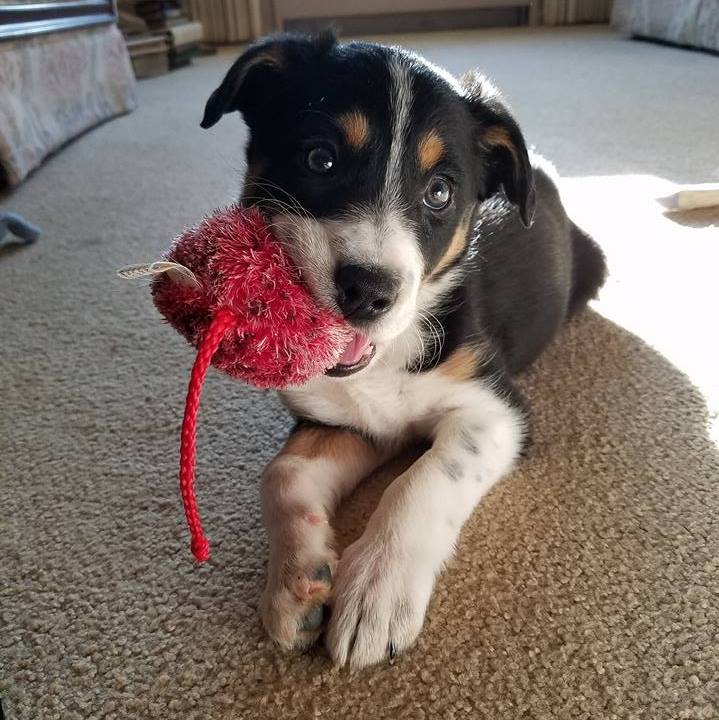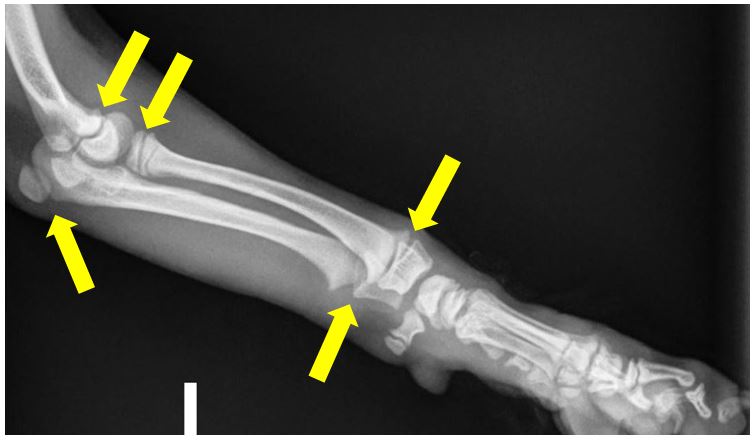All About Exercise for Puppies
By Cathryn Adolph, LVT, CCRP, CCFT

Burning Off Energy
Puppies are happy bundles of fluff that are always learning. With all their exuberance, many owners look to exercise to “burn off energy.” What many of us don’t realize is that repetitive and high impact exercise can cause damage or injury. Puppies can grow so fast that, for some breeds, it is actually easy to forget they are still growing. In this blog we will examine types of exercise and give some basic guidelines to help burn off puppy energy in a safe manner.
Developing Bodies
Puppies grow a lot in a short amount of time. From an orthopedic standpoint, their bones are still spongy and their growth plates are increasing the length of the bone itself. Tendons and ligaments are soft tissues that attach muscle to bone and bone to bone respectively. The tension that tendons and ligaments apply to bone tell the bone where it needs to be stronger, aka grow thicker. At this stage, it is crucial to remember that the soft tissue is stronger than the bone. The picture on the left shows highlights just some of the growth plates in the forelimb.

In an adult dog, the growth plates have calcified over and they are considered “closed.” Growth plates closure occurs, on average, at 12-18 months old, with variations based upon breed. Adult dogs’ bones are fully developed and now stronger than the surrounding tendons and ligaments. A rotation or bend the wrong direction for an adult dog is more likely to result in a strain to the soft tissue. In puppies, the same extreme rotation or bend can result to damage to the bone itself. Injuries can result in fractures and/or damage to the growth plates.
Injuries to the growth plate can cause permanent injuries that follow the dog for life. Bones may not grow to their full length or even grow unsymmetrically, resulting in the outer or inner edge of a long bone to grow faster than the other half.
Free-Play versus “Forced-Exercise”
For young puppies free play is a great way to exercise. Free play is when they can run, romp, and explore on their own. The puppy can flop and take a rest at any time. Free play and exploration allows the puppy to set the pace without overdoing it.
Repetitions and timed exercise can often lead owners to overdo it with their puppies and adult dogs. When we have a number or goal, we put pressure on ourselves to meet that goal. This can also include long walks and hikes.
Lack of Exercise
While exercising your puppy sounds scary, locking our puppies up to ensure their safety is just as bad as repetitive exercise. Developing bone tissue needs the stress of movement to get stronger. Bone needs to be thicker at joints and where muscle attaches to the bone. In human studies, children who regularly exercise are less likely to break a bone as an adult.
Tiring Out a Puppy
Mental exercise can be just as tiring as physical exercise. Engaging their mind and using their scent abilities are a great place to start. Other ideas and tips for puppy enrichment include:
- Placing a puppy kibble trail or tossing a handful of food in grass is a great way to burn off energy. The puppy has to work hard to find the food with their nose.
- Training behaviors and use of instability equipment should be “exposure” based, not repetition based.
- For example, a puppy trail of FitPaws instability equipment will allow your puppy to explore and have a positive experience with the equipment while keeping them close to the ground. A few passes can help tire your puppy out.
- Tricks are a great way to teach fun behaviors and mentally tire out a puppy. Keep your repetitions low by counting out five to ten cookies and/or set a timer for one minute per age in months.
- Tricks that place a large amount of physical stress on the body, such as sit pretty, should be avoided. The torque produced can create minor injuries on the bone.
Exercise Can be Safe and Fun
Exercise can be safe, engaging, and fun for our puppies. Planning ahead and thinking of exposure versus repetitions will give your dog a great foundation for adulthood while supporting their orthopedic health.
A note about stairs:
A 2012 study of Newfoundland, Labrador, and Leonberger puppies found a correlation between daily stair use in puppies under 3 months old and an increased risk of developing hip dysplasia. Even though the chosen breeds have a high incidence of the disease, stair use had a higher rate of developing the disease. However, the same study showed that off leash exercise on hills with varying terrain decreased the risk of hip dysplasia.
